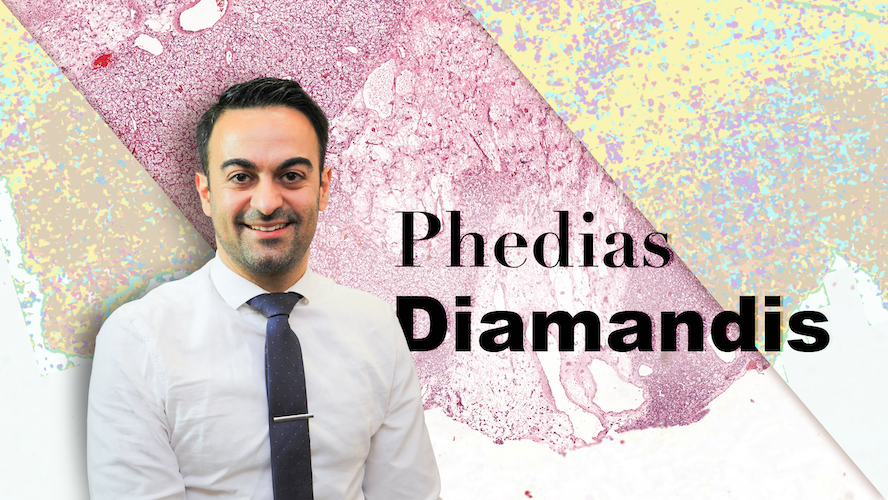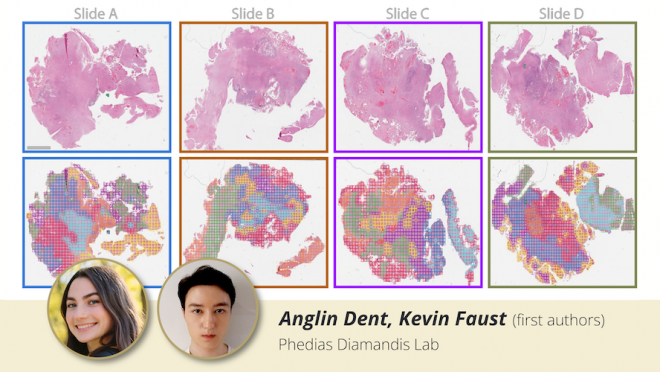
AI for brain cancer
“It is a scary topic when someone tells you that your job is going to be replaced by AI,” says Dr. Phedias Diamandis, a neuropathologist at UHN.
Modern AI's image analysis mirrors a pathologist's clinical skills in examining microscopic tissue images to diagnose diseases. Concerns about AI overtaking pathology have existed for years.
To transform the challenge into opportunities, Phedias stepped foot in the world of AI in 2017, when the concerns began to spread.
“I wanted to see if AI can interpret pathology images like humans are trained to do.”
Drawing upon his neuroscience background and extensive self-learning, Phedias discovered that AI learns in a manner comparable to humans.
"Our perception relies on neural networks in our brain. In the visual system, primary visual centers detect basic shapes like circles and squares, while higher-level centres integrate them into complex objects. Similarly, AI analyzes images by identifying basic shapes through spatial coordinates and checking for spatial distribution to recognize familiar patterns."
With an understanding of how AI works and a goal to apply AI in pathology, Phedias’ team started a research project to train AI to recognize tumour histology slides.
The team fed AI nearly 1 million images collected from over 1,000 brain tumors, each annotated by pathologists. Using deep neural networks, they developed a tool to analyze cell patterns and generate a map highlighting distinct regions of the tumor with their unique histomorphological features.
They call this AI-driven tool “HAVOC” (Histomic Atlases of Variation Of Cancers). HAVOC aims to help researchers better understand tumour heterogeneity–a phenomenon where different regions of a tumour can have different biology, which can lead to different treatment responses and resistance. Understanding cancer variations helps guide personalized treatment and improve precision medicine.
But how well does it work?
The team used whole slide images from six high-grade glioblastomas to test HAVOC’s accuracy. As the images are processed through the deep neural networks, HAVOC extracts the morphology features from small patches of each image and clusters the patches by similarity to mark different regions in the original image.
It turned out that the results obtained by HAVOC are consistent with the interpretations made by human experts and are correlated to the molecular variations in the sample. In some cases, the variations in molecular features predicted by HAVOC could support the use of personalized combination therapies for patients (published in Science Advances).
“HAVOC can assist pathologists to understand tumour heterogeneity directly from histology slides,” says Phedias. “It’s a useful tool to complement other molecular approaches and contribute to ongoing personalized medicine efforts.”

Using deep neural networks to map tumour histomorphology variations. The first row of images are H&E histological slides from a high-grade glioma and the second row includes their respective HAVOC heterogeneity maps. The coloured clusters proposed by HAVOC map are intra-tumour variations in cancer biology that can one day help inform custom therapy design for patients (from Science Advances).
Empowering the community
“The danger of AI is that we are not really sure how it behaves in new situations,” says Phedias.
“When humans encounter an unexpected situation, we know it's better to be cautious and avoid a mistake rather than trying to fit it into a mathematical formula, but this is not the case for AI.”
Taking a rare brain tumour as an example, a case that only occurs once every ten years can still fire up the neuronal connections in a pathologist’s brain to alert them to be mindful when making a diagnosis. However, when a computer encounters a rare tumour, it can make a guess based on probability and problems arise. When adding up the probabilities of running into different types of rare tumours, it can mount up to 10-20% of the total cases and it is very difficult to train a system to properly react to them.
“In addition to a large training data set, it's also important to consider the creator's artistic ability to develop intelligent algorithms that perform well in specific circumstances,” says Phedias. “We need to rely on the community through crowdsourcing to solve some of those rare circumstances.”
To better include rare cases and expand HAVOC’s application in different disease areas in pathology, Phedias’ team has developed PHARAOH (PHenotyping And Regional Analysis Of Histology), an open online platform that makes the HAVOC map accessible and easy to generate.
Researchers and pathologists can tweak the parameters to design and develop their own AI tools on PHARAOH, based on their specific pathology expertise and needs. PHARAOH allows users to share their creations with the entire community to avoid duplicating efforts.
“The motivation behind PHARAOH is to enable clinicians to contribute and utilize computational pathology without the need to have a deep understanding of the advanced coding needed to design AI algorithms,” says Phedias.
Phedias explained how to utilize PHARAOH in this YouTube video in detail.
In 2019, Phedias created the YouTube channel NeuroscIQ, an online space to foster education and curiosity within the world of neuroscience. He and motivated students in his lab have been contributing to the channel over the years, sharing their most updated research information, and dissecting neuroscience breakthroughs for lay audiences.
“It has been something I wanted to do since my residency, because I’m fascinated by the idea of disseminating knowledge quickly in a free and scalable manner to anyone who wants to consume it. That is how I learned.”
“It took me eight years to take the action, and I wish I started earlier,” Phedias recalls. “When I was contemplating it, I feared that people might not receive my content well. But it turns out, people generally see sharing as a positive thing and they are appreciative to hear other people’s points of view.”
Training for a marathon
The complexity of neuroscience initially deterred Phedias from studying the brain systematically, until it became a necessity for his PhD work.
The daunting task of starting a YouTube channel was not realized for eight years until his motivation to share eventually overcame perfectionism and the fear of potential critique.
The rise of AI poses an uncertainty for the future but Phedias jumped in to make it a tool that can empower the field.
Each time when facing unfamiliarity, the fear does not go away, but it takes Phedias less time than before to react to it.
“If you're scared of something, it's probably something that will make you stronger if you eventually embrace it,” says Phedias.
Phedias trained for a marathon once. Eight weeks in, he went from only being able to run two kilometers on the first practice, to finishing the entire 42 kilometers on the day of the marathon. This training experience has shed light for him on how to approach the daunting quests in life.
“I don't get as overwhelmed trying to learn a new skill as I did before,” says Phedias. “During training, you never actually fully run a marathon. You just need to get yourself to a specific level where mentally you know that this can be done and you can complete it.”
“Some of the biggest barriers are not our capabilities, but our mental approach to the problem in front of us. My training partner at the time gave me some good advice. If something seems outside of your current capabilities, start by breaking it into smaller pieces that you know you can achieve. For running, he would say, just try and get to the next lamppost on the road. Once you get there, then just do that again and again until the run is over.”
Meet PMResearch is a story series that features Princess Margaret researchers. It showcases the research of world-class scientists, as well as their passions and interests in career and life—from hobbies and avocations to career trajectories and life philosophies. The researchers that we select are relevant to advocacy/awareness initiatives or have recently received awards or published papers. We are also showcasing the diversity of our staff in keeping with UHN themes and priorities.




